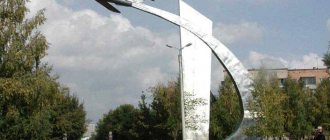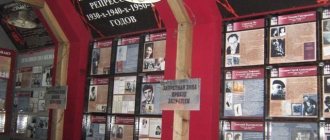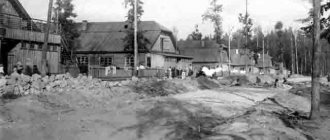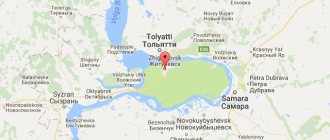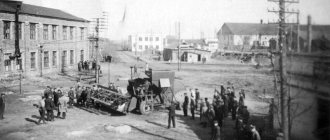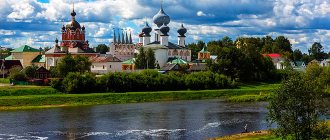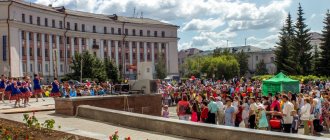The history of Kaspiysk begins with the construction of a military enterprise for the production of naval weapons on the territory of Dagestan. The decision to build it was made in 1931 at a meeting of the Politburo of the Central Committee of the All-Union Communist Party of Bolsheviks.
Construction of plant No. 182 (since 1966) began in 1932, 14 km from the city of Makhachkala in a narrow strip between the sea and the mountain range among swamps, salt marshes and sand dunes. In the same year, a group of engineers and designers from Leningrad set up the tent city “Dvigatelstroy”, which on September 17, 1947 was renamed the city of Kaspiysk.
The construction of the city was declared an all-Union Komsomol construction project. Every day new people came to build the plant and the city: masonry masters from Armenia, formwork workers from Arkhangelsk, Dnepropetrovsk concrete workers, diggers from Kuban and Stavropol, engineers from Moscow and Leningrad, stonemasons from the mountain villages of Dagestan. Yesterday, the still deserted steppe quickly became covered with multi-colored tarpaulin tents. And an endless convoy of two-wheeled carts pulled towards the construction site, transporting building materials. The country's best young specialists - engineers, doctors, workers, teachers - came here. Just eight years later, the tent village turned into a real city: a huge factory, a thermal power plant, beautiful multi-storey buildings, two new schools, a clinic, a hospital, a stadium, a club, a hotel, a library, a dance floor, etc.
In 1940, plant No. 182 became one of the largest enterprises in the North Caucasus. The production area of the plant amounted to almost 115 thousand square meters, the number of workers was more than 6 thousand people. The village of “Dvigatestroy” had about 17 thousand inhabitants at that time. It consisted of two parts: the multi-storey part was called “social city”, and the second, located behind the railway, between the bread factory and the old military registration and enlistment office building, was called “standard houses” or “quarter”. The social city consisted of about two dozen two-, three-, four-, five-story houses, and all standard houses were two floors made of wooden panel blocks. All of them were built before the war.
Before the war, a factory club by the sea with a city library, the 1st and 2nd secondary schools, a clinic and a hospital were built. The village was immediately created as a sensitive facility, and therefore was surrounded by a two-row fence with barbed wire and floodlights along the perimeter. It was possible to enter or drive to Dvigitalstroy only if you had registration in your passport or a special pass. The fence ran from the sea near the Second Turals, approximately along the road that now leads to the Airport, skirting a stone quarry and beyond the cemetery it again came out to the sea. The city bazaar was located behind the fence, approximately on the territory of the current service station.
You could travel to Makhachkala from the village either by train (there in the morning, back in the evening) or by narrow-gauge railway on a handcar, popularly called a “cuckoo”. It consisted of two small trailers. The narrow-gauge railway began in the area of the railway station, passed by the clinic, then along S. Stalsky Street to the sawmill located on the seashore. There she turned towards Makhachkala. The trolley made stops at the Second and First Turals, and when crossing the zone at the Second Turals, all passengers' documents were checked.
At that time, between the village. “Dvigatelstroy” and Makhachkala were continuous sand dunes with sparse vegetation and specific fauna: snakes, lizards, jerboas, gophers. Therefore, sometimes due to sand drifts the railcar went off the rails; At the request of the driver, all adult passengers got out of the carriages, lifted the trolley and placed it on the rails. Such a trip to Makhachkala took from 3 to 4 hours.
During the Great Patriotic War, Plant No. 182 supplied the front with weapons and ammunition. The plant also produced aircraft and depth charges, anti-aircraft shells and mines, mortars, PPSh and anti-tank hedgehogs. About 800 residents of Dvigitalstroy were awarded military and labor awards, and 200 workers received medals “For the Defense of the Caucasus.” Alexander Nazarov and Magomed-Zagid Abdulmanapov were posthumously awarded the title of Hero of the Soviet Union.
In 1943, the plant’s staff received the gratitude of the Supreme Commander-in-Chief, and in 1945, the Red Banner of the State Defense Committee of the USSR. In 1948, plant No. 182 mastered the production of diesel engines, which were supplied to more than 34 countries around the world.
In the fifties, Kaspiysk was also a supplier of self-propelled balers, units for silage combines and other agricultural equipment (this tradition, by the way, continues now, in difficult times of conversion, when the production of haymowers and other civilian products allows us to maintain life at Dagdizel ). But, of course, the most prestigious area of the plant’s work in the period from 1957 to 1964 was the production of military missile technology.
The product was a water-to-water missile designed to destroy enemy surface ships and coastal fortifications. In short, it was the world's first sea-based cruise missile, and it was created in Russia, in Dagestan, in Kaspiysk!
In 1960, another enterprise of the military-industrial complex came into operation - the Caspian Precision Mechanics Plant, which specialized in the production of navigation and ship equipment. Currently, JSC Caspian Precision Mechanics Plant is the only supplier of navigation systems for submarines of the Russian Navy, and in recent years it has been developing a new line of activity - the production of cabinet gas control units of the ShBDG type with various capacities.
The production and scientific potential of the city of Kaspiysk was undoubtedly complemented by the branch of the Gorky Shipbuilding Plant, built in the late 60s. It is here that the assembly and flight tests of ekranoplanes are carried out - giant flying ships that have no analogues in world shipbuilding and still amaze the imagination. The secrecy conditions of those years did not allow us to say that both the Caspian Sea and Kaspiysk were chosen for the completion and testing of military ekranoplanes by their creator Rostislav ALEKSEEV, a great designer whose scale of talent and accomplishments are comparable to the deeds, projects and achievements of such giants of engineering as A. Tupolev and S. Korolev.
A high technological level or, as they say now, science intensity has always determined production at Kaspiysk factories and special increased intellectual requirements for personnel. Therefore, many Caspian residents, having completed vocational training at city enterprises, then moved on to responsible economic work in the republic and abroad.
Thirty people are included in the Book of Honorary Citizens of the city. Teachers P.N. left a good mark on the history of Kaspiysk. Derevianko, Z.A. Azizagaev, I.I. and 3.E. Aslanovs, A.A. Abasov, G.K. Gasanov, N.I. Shishakina, doctors K.N. Zubovich, M.G. Askenazy, A.K. Zakuev, P.Kh. Budyko, national economy specialists E.F. Eyubov, K.G. Gasanov, R.A. Dzhanaev, M.M. Ain, T.G. Alkhazov, Hero of the Soviet Union G.D. Ilyashenko and many, many other Caspian residents.
General information and history of Kaspiysk
Stela Kaspiysk
As can be logically concluded from the name, the city of Kaspiysk is located on the shores of the Caspian Sea (popularly known as the Caspian). The small satellite city of Makhachkala does not have as long a history as the capital of Dagestan. Until the end of the 40s, it was an urban-type settlement with the proud name of Dvigatelstroy. Then it was renamed.
Today, cottage villages spreading from the borders of both cities have begun to intertwine, like tree roots, and have practically united them. As the local population suggests, in a few years the question may arise of Kaspiysk becoming part of Makhachkala. The city is 14 km away from the Makhachkala railway station (practically the center), and Uytash airport is just a stone's throw away - no more than 5 km. Compared to the distances of Moscow, St. Petersburg or another large Russian city, these are ridiculous numbers.
The area named after Lenin
Despite the fact that it is located on the seashore, Kaspiysk has not become a resort and is unlikely to ever become due to the military units and strategic plant located on its territory.
Automobile highways
The following roads pass through the city of Kaspiysk:
- P217 "Caucasus" is a federal highway with a length of 1118 km. The road is part of two European routes: E119 and E50. It passes through the territory of the Krasnodar Territory, Dagestan, Stavropol Territory, Ingushetia, North Ossetia, Chechnya, Kabardino-Balkaria. The final point of route P-217 is the state border with Azerbaijan. The road surface is asphalt.
- P215 is a regional highway with a total length of 470 km. It is part of the European route E119 and the Asian route AH8. Passes through the territory of Dagestan, Astrakhan region and Kalmykia.
- R275 is a regional highway with a total length of 100 km. It is part of the European route E119 and the P-217 highway. The road passes through the territory of Dagestan.
- E119 is a European route that connects Iran, Russia and Azerbaijan. The total length of the route is 1,730 km.
- E50 is a European route that passes through the Czech Republic, France, Slovakia, Germany, Russia, and Ukraine. The length of the route is 6,000 km.
Climate and ecology of Kaspiysk
Kaspiysk, like other southern Russian cities, boasts relatively mild winters. The temperature in January-February rarely drops below -10 degrees. True, a damp, cold draft often blows from the sea, so the cold is felt more strongly. There is little snow falling and it melts quickly.
Spring comes on time; cherries and apricots already bloom at the end of March. Summer in Kaspiysk is hot, and without air conditioning indoors is difficult to tolerate. The most exhausting period begins in mid-June and ends in August.
Park by the sea
Until recently, Kaspiysk was almost as dirty as Makhachkala. Black garlands of garbage bags decorated the trees along the highways, and the aroma from overflowing garbage cans spread for several meters around. The reason for this was, first of all, the concept of the average Dagestani “Everything outside the window is not my territory,” as well as the belief that a janitor is a shameful profession for a mountaineer (or mountaineer). Now the situation has improved significantly. And janitors appeared, and propaganda posters calling on citizens to maintain cleanliness not only in their own apartment.
The road surface is being improved, ugly “shell” garages are being eliminated, and there are touching inscriptions on garbage cans: “Don’t set me on fire! Do you need me". There are no other particularly dangerous sources of environmental pollution (except for local residents) in Kaspiysk.
Cow on the street. A typical picture for the private sector of Kaspiysk
Sports Palace named after Ali Aliyev
Palace of Sports and Youth named after. Ali Aliyeva is a modern multi-sports indoor sports palace, named after the famous Soviet wrestler. This is the largest indoor sports facility in the entire North Caucasus Federal District. Its total area is 17 thousand square meters, the capacity of the stands is 5 thousand people. More than a thousand people can exercise at the same time in its multidisciplinary halls. The complex is also the playing arena for the Dagestan volleyball club.
Sports Palace named after Ali Aliyev
Address: Akulinicheva Avenue, 19.
Population of Kaspiysk
Since the formation of Kaspiysk, its population has only been growing. At the beginning of 2014, just over 105 thousand people lived in the city, which, again, is not much by Russian standards. Almost all 35 nationalities of Dagestan are represented.
During Soviet times, Kaspiysk was considered a “Russian” city. There were many Russians here who worked at the Dagdizel plant, as well as residents of military units. In the summer, relatives came to these residents, and the Russian-speaking population almost doubled. Today, Russians make up about 10% of the Caspian population (5th place in number). Those who left are in no hurry to return due to the unstable situation in the republic and lack of work. The attitude towards those who remain is tolerant, since they are mostly old residents of the city who have many acquaintances. And the legendary mountain hospitality does not order to offend neighbors if no harm comes from them.
Youth Day in Kaspiysk
The absolute majority of the townspeople are Muslims, with no more than 15% Christians. The growth of religious self-awareness of the mountaineers is becoming more and more noticeable. If five years ago in Kaspiysk a woman in a hijab or a man with a long beard was seen off with a surprised look and whispers, now this is a common occurrence. Despite their numerical superiority, Christians in Kaspiysk are treated loyally. Here you will not see nationalist graffiti on the walls, and no one desecrates the church in the city center. Basically, Caspian residents are secular people who respect the Constitution and mountain adats, and even those are selective.
There are quite a lot of young people and young families in Kaspiysk. And a lot of children. Boys and girls strive to get a higher education, but for many it is still a matter of prestige, and not a real opportunity in the future to get a job in their specialty. Despite a significant degree of Europeanization, the adult part of the population still retains some conservative norms of behavior: on the street you will not see a man in shorts, a woman dressed too provocatively, or a couple kissing.
Eighth workshop - Soviet Fort Bayard
Workshop No. 8, designed for testing and shooting torpedoes, was built 2.7 km from the coastline of Kaspiysk and began operation in 1937. It stands directly in the sea, on a specially poured stone “pillow” 6 m high and on a concrete base, which also has a height of over six meters.
The total area of the “fort” is more than 5 thousand square meters. The height of its observation tower is 42 meters. The thickness of the underwater walls is one and a half meters. The workshop was equipped with an elevator to the tower, a dormitory for 60 people, a cinema, a canteen, and a library. A cable running from the shore along the bottom of the sea supplied electricity, and it also had its own diesel power station.
During the Great Patriotic War, the Germans wanted to capture this structure intact. They bombed the harbor of Kaspiysk, but did not throw bombs at workshop No. 8. The workshop was actively used until 1959. In 1966 it was closed because... torpedo production technologies had advanced far, and its use was no longer advisable. Until the end of 1976, workshop No. 8 was under guard. But on December 29, 1976, it was removed and the structure was abandoned.
Eighth workshop - Soviet Fort Bayard
Now it is in a deplorable state. Firstly, after the rise of the Caspian Sea (1978−1995), waves with massive ice floes thoroughly broke its base. Secondly, in the 1980s, shots were fired at the building from the Lun ekranoplane, an original design of a Soviet-era combat vessel/aircraft. The tower on the right side was hit and tilted slightly. Other shells hit the front part of the workshop - the firing ports, which had previously been covered so that water did not enter the workshop even during a storm. After the shelling, water began to penetrate inside and began to destroy the building intensively. And the fire that started from the shelling destroyed everything inside the workshop in a few days.
The mere sight and lack of security of this grandiose object attracts stalkers, romantics and simply curious people. Local residents will gladly take you to the old “fort” by motor boat for a small fee. Subject to good weather and no rough seas.
Plans to turn the eighth workshop into a popular tourist attraction, similar to the famous Fort Bayard, which are voiced in the republic from time to time, remain only fruitless dreams.
Districts and real estate of Kaspiysk
Map of Kaspiysk
Every year the city expands, fortunately the desert area around allows this to happen. As mentioned above, in the north and in the region of New Khushet it practically merged with Makhachkala. To the west, expansion does not occur at such a rapid pace, and in the south, Kaspiysk ends completely.
Northern entrance to the city
Today Kaspiysk covers an area of 33 square kilometers and is divided into three areas: a military town, a stone quarry and the private sector.
In a military town, the majority of residents are military men and their families, the rest are mere mortals. Large areas are unofficially divided into microdistricts, which generally bear the names of some nearby popular objects: the area of Lake Turali, a brick factory, Anzhi, Cultural Park, etc.
Stadium for Anzhi on the outskirts of the city, Anzhi microdistrict
The streets almost everywhere follow the “American layout” - parallels and perpendiculars, so getting lost is problematic.
The most prestigious neighborhoods are considered to be in the city center (Khizroev St., Akhmet Khan Sultana) and on the seashore (Lenin St., Khalilov St.), but they are not very pronounced, since the city is small, and the center is a 10-minute drive from the most distant district. Prices for apartments in Kaspiysk are already comparable to those in Makhachkala, both in terms of renting and purchasing housing. Renting a one-room apartment costs at least 8,000 rubles/month (if the renovation is not great and there is no furniture). The cost of purchased housing depends on the stage of construction of the house and the size of the apartment. The estimated 1-room apartment will cost approximately 400,000 rubles, the frame - from 600,000 rubles, a lived-in nest - from 800,000 rubles and more.
The “Old Town” in Kaspiysk is a collection of nostalgic five- and nine-story buildings lined with trees, including fruit-bearing ones. Quiet green streets, small shops and cafes, of which there are many in every district, touch the soul. Unfortunately, Kaspiysk cannot boast of an exquisite style or architectural monuments.
The private sector on the southern outskirts of the city consists of streets stretching along fences of various sizes. Unfortunately, in none of the cities of Dagestan there are architectural plans for private houses, so buildings of all possible styles and colors do not combine with each other. On the one hand, this gives unlimited scope to the owner’s imagination, on the other hand, Kaspiysk does not have its own recognizable style, like European or American towns.
Typical Dagestan house
There is no distinct business center, residential areas or slums in Kaspiysk. There are some elite high-rise buildings and private houses, but overall the city looks the same in the Soviet style. There are few “party” places - the Moscow entertainment complex and the Orion cafe.
Entertaining, located in a park by the sea
Young people simply walk along the streets and in the Park of Culture, or go for walks in Makhachkala, where there are more opportunities to have a good time.
Entertainment complex "Moscow"
A modern building next to the sea embankment of Kaspiysk, which houses all the entertainment and types of cultural recreation and leisure popular in our time. This is a multiplex cinema, bowling alley, karaoke, bars, cafes and restaurants, a fitness club with a gym and a swimming pool, a sauna, a beauty salon, concert, conference and banquet halls, and a night club. This is the center of the entire cultural and entertainment life of the city of Kaspiysk. Its owner is Magomed Abdullaev, who is also the chairman of the board of the Izberbash Wine and Cognac Factory and the son-in-law of the former mayor Jamaludin Omarov. In 2014, the owner of Moskva took the post of mayor of Kaspiysk.
Entertainment complex "Moscow"
Address: st. Khalilova, 12a.
Infrastructure condition
All houses in Kaspiysk are divided into private buildings and “sections” (high-rise buildings with 5 floors and above). High-rise buildings in most cases are panel houses from the Khrushchev era, 5 or 9 floors high. From the outside they are a sad sight, but inside the apartments can shine with European-quality renovation and fabulously expensive furniture. The city is now experiencing a construction boom, which has resulted in the construction of more modern high-rise buildings. The private sector is, accordingly, private houses with their own fenced area. The architecture is anything from old adobe houses to luxurious mansions with turrets.
In general, as far as housing and communal services are concerned, Kaspiysk compares favorably with Makhachkala: the light “goes out” extremely rarely, the heating works well, and the elevators also stopped being turned off after 9 pm. The only rather serious problem that city authorities still cannot solve is water “by the hour.” The schedule is strict: water is served from 6 to 9 am, then at lunch from 12 to 2 and in the evening from 18.00 to 21.30. Therefore, in every house/apartment, in the bathroom, you will definitely find either a couple of huge buckets of 50 liters or more, or a squad of 5-liter drinking water bottles.
There are two main types of transport in Kaspiysk - minibuses and taxis. The cost of one trip on a minibus to any part of the city is 12 rubles in 2013. A taxi will cost 50-70 rubles, and calling a car by phone will cost less than “voting” on the highway. There are no state modes of transport here, so there is no concept of a “pass”. The roads are generally good, there are no traffic jams. Recently, the construction of the new Kaspiysk-Makhachkala highway was completed, and now you can get to the capital in about fifteen minutes. This is very important for Caspian residents, since many go to Makhachkala every day to work.
City station
Like other large cities of Dagestan, Kaspiysk has a catastrophic shortage of kindergartens. A place for one child costs 20-30 thousand rubles. If you don’t “give it a go,” the child runs the risk of waiting his turn at school. In principle, there are no places outside the queue for large families and single mothers. The situation with schools is a little better, but classes are also packed.
In Kaspiysk there are clinics for children and adults, a hospital, and a maternity hospital. All of them are in a rather deplorable state for the 21st century, and most importantly, it is very difficult to find a doctor who would treat an unfamiliar patient humanely if he does not have a banknote or, in extreme cases, a box of chocolates. Also in the city there is one of the best eye clinics in the republic - the Eye Microsurgery Center. Citizens were able to appreciate the advantages of paid medicine (modern building, absence of kilometer-long queues, coolers, etc.), since several paid medical centers opened in the city, including those from the “Healer” network of clinics and pharmacies.
Football stadium "Anji Arena"
The home of the professional football club Anzhi (Makhachkala) was built in 2003 and was originally called Khazar. The capacity of the stands is 26,400 spectators. In 2011, it was decided to reconstruct it, strengthen it taking into account the strong winds that occur in this area, and increase the number of seats to 30 thousand. The renovated stadium was named “Anji Arena” and opened in 2013.
Football stadium "Anji Arena"
Address: Akulinicheva Avenue, 21.
Enterprises and work in Kaspiysk
The large enterprises Dagdizel and the Caspian Precision Mechanics Plant located in Kaspiysk are still operating. This is a surprising and pleasant fact, because many Dagestan factories died for a long time after perestroika. The factories are smaller and completely owned by private individuals - a clothing factory, a winery, a bakery and several factories specializing in construction.
By the way, the construction business in Kaspiysk and in Dagestan in general is a highly profitable and highly competitive industry. However, several scandals are associated with it, when law enforcement agencies discovered that real slaves were working in factories - people whose documents were taken away and forced to work for a piece of bread against their will.
Most city residents work in smaller enterprises, and even more often - for themselves or for one of their relatives. In Kaspiysk you can open a bakery, a hairdresser, a wedding salon, an on-call taxi, a mini-deli, a cafe. Local craftsmen are engaged in tailoring, both in the studio and at home, without opening an individual entrepreneur. Enterprising businessmen are opening banquet halls for weddings: in Dagestan it is customary to invite a lot of people to a wedding; ordinary restaurants cannot accommodate so many guests. Such halls are in constant demand, and the schedule of the most popular ones is scheduled months in advance.
You can always get a low-paid, unskilled job, but to get a position higher than a senior cashier you have to work hard. And this does not guarantee a promotion, since money and family connections decide a lot. More conscientious entrepreneurs even hide from relatives that a good position has become vacant in their company - in order to hire a truly competent specialist, and not a second cousin of their cousin. It is not customary to refuse if you are asked to accommodate a relative.
There are no large shopping centers in Kaspiysk, like in Makhachkala. There is a chain of supermarkets “Pyaterochka”, the concept of which is different from what, for example, Muscovites are used to. Here it is not an economy class store, but an average one and in some cases even a luxury one. Citizens prefer to shop in nearby shops or markets. There are four markets in the city: central, clothing, wholesale and small. There is also a car market, the only one in Dagestan, it is located on the highway between Kaspiysk and Makhachkala. Brand new cars from Moscow and Europe are brought here, as well as new owners for their old iron horses.
Aqualand water park near the Anji stadium
Finding the most modern water park in Dagestan, Aqualand, is not difficult: it is located on the Kaspiysk-Makhachkala road, from which you can see bright signs and water slides inviting you to fly. Intended for visitors of all ages, the Caspian water park "Aqualand" offers a full range of water attractions. The pools are divided into age zones and equipped with several slides of varying lengths and heights. Artificial waterfalls and geysers have been built. There is a recreation area around the water attractions, with cafes, lawns and cozy shady places.
Aqualand water park near the Anji stadium
Criminal situation
Kaspiysk is a quiet and calm town. Due to the fact that there are few enterprises here that can be divided up, and the entire elite lives in Makhachkala, there are no showdowns between criminal structures. They usually shoot at weddings or during a special operation in a cordoned off area.
Special operation in a cottage area on the outskirts of Kaspiysk
Thefts happen. There are practically no rapists and pedophiles - due to the peculiarity of the mentality of the mountaineers. Residents calmly let children go out alone from the age of 5-6; it is safe to move around the city at night.
Unlike Makhachkala, terrorist attacks also bypass Kaspiysk. It’s not that they don’t exist at all, but they don’t happen as often as in the capital. The largest terrorist attack that thundered throughout Russia occurred in 1996. Then, as a result of the explosion, a dormitory for military personnel and their families collapsed, out of 106 people, 67 died. Some call the “forest brothers” the culprits, others call them criminal structures that took revenge on the border guards. Another infamous explosion occurred on May 9, 2002 during the Victory Parade. It claimed the lives of 43 people.
Monument to the victims of the May 9 terrorist attack
The organizers were considered to be militants, although none of the field commanders took responsibility for the terrorist attack, justifying this by the fact that they were not at war with the civilian population. In general, if you stay away from police and traffic police posts, you can consider yourself relatively safe in Kaspiysk. It is also categorically not recommended to touch suspicious objects on the street, or to lift or kick packages and boxes - in Dagestan, including Kaspiysk, civilians were blown up several times by disguised bombs.
Palace of Culture
A large monumental building in the style of Stalinist architecture, which was completely completed after the death of the leader, in 1961. Which, apparently, somewhat changed its original appearance towards simplification. Nowadays, this cultural institution also remains on the balance sheet of the plant, but practically nothing happens in it. The theater building of the building is closed, and in the second building some clubs for children are held.
Palace of Culture
Address: st. Mira, 7.
